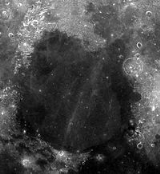
Mare Serenitatis
Overview
Lunar mare
The lunar maria are large, dark, basaltic plains on Earth's Moon, formed by ancient volcanic eruptions. They were dubbed maria, Latin for "seas", by early astronomers who mistook them for actual seas. They are less reflective than the "highlands" as a result of their iron-rich compositions, and...
that sits just to the east of Mare Imbrium
Mare Imbrium
Mare Imbrium, Latin for "Sea of Showers" or "Sea of Rains", is a vast lunar mare filling a basin on Earth's Moon and one of the larger craters in the Solar System. Mare Imbrium was created when lava flooded the giant crater formed when a very large object hit the Moon long ago...
on the Moon
Moon
The Moon is Earth's only known natural satellite,There are a number of near-Earth asteroids including 3753 Cruithne that are co-orbital with Earth: their orbits bring them close to Earth for periods of time but then alter in the long term . These are quasi-satellites and not true moons. For more...
.
It is located within the Serenitatis basin, which is of the Nectarian
Nectarian
The Nectarian Period of the lunar geologic timescale runs from 3920 million years ago to 3850 million years ago. It is the period during which the Nectaris Basin and other major basins were formed by large impact events...
epoch
Epoch (geology)
An epoch is a subdivision of the geologic timescale based on rock layering. In order, the higher subdivisions are periods, eras and eons. We are currently living in the Holocene epoch...
. The material surrounding the mare is of the Lower Imbrian
Lower Imbrian
In the lunar geologic timescale, the Early Imbrian epoch occurred between 3850 million years ago to about 3800 million years ago. It overlaps the end of the Late Heavy Bombardment of the inner solar system. The impact which created the huge Mare Imbrium basin occurred at the start of the epoch...
epoch, while the mare material is of the Upper Imbrian
Upper Imbrian
In the Lunar geologic timescale, the Late Imbrian epoch occurred between 3800 million years ago to about 3200 million years ago. It was the epoch during which the mantle below the lunar basins partially melted and filled them with basalt...
epoch. The mare basalt
Basalt
Basalt is a common extrusive volcanic rock. It is usually grey to black and fine-grained due to rapid cooling of lava at the surface of a planet. It may be porphyritic containing larger crystals in a fine matrix, or vesicular, or frothy scoria. Unweathered basalt is black or grey...
covers a majority of the basin and overflows into Lacus Somniorum
Lacus Somniorum
Lacus Somniorum is a plain located in the northeastern part of the Moon's near side. It is located at selenographic coordinates 38.0° N, 29.2° E, and has a diameter of 384 kilometers...
to the northeast. The most noticeable feature is the crater Posidonius
Posidonius (crater)
Posidonius is a lunar impact crater that is located on the western edge of Mare Serenitatis, to the south of Lacus Somniorum. The crater Chacornac is attached to the southeast rim, and to the north is Daniell....
on the northeast rim of the mare.
Unanswered Questions

